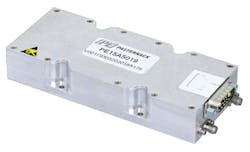Download this article as a .PDF
Efficiency is often the difference between a power amplifier (PA) being selected or rejected for a particular application. Because higher-power PAs can require large amounts of bias energy to achieve a target output-power level, a difference in efficiency of just a few percent can mean a difference in the size and cost of a power supply for a particular PA. A basic overview of PA efficiency can also help to better understand how that efficiency can impact the overall performance of a system, as well as the performance of other PA parameters (notably linearity).
An amplifier with high efficiency uses power-supply energy more effectively than an amplifier with lower efficiency. At lower efficiency levels, wasted power-supply energy is typically converted into heat at the amplifier’s active devices, which are increasingly gallium-nitride (GaN) transistors for RF/microwave PAs. GaN high-electron-mobility-transistor (HEMT) devices are noteworthy for a number of features that enable high-efficiency PAs at microwave frequencies, including high breakdown voltages, high current densities, high transition frequencies, low on-state resistances, and low parasitic capacitances. To protect the active devices and the surrounding electronic circuits, the heat must be removed. This results in the need for additional hardware, such as fans and heatsinks, which can add to the size, weight, and cost of a power amplifier.
A PA’s efficiency is often denoted by the symbol η. It can be defined by the relationship
η = (signal power delivered to the load)/(DC power supplied to the output circuit) (1)
It can also be expressed as the power-added efficiency (PAE), as
PAE = (Pout – Pin)/PDC (2)
where
PDC = the bias energy applied to the amplifier;
Pin = the input signal waveform power fed to the amplifier; and
Pout = the output power level of the signal waveform produced by the amplifier.
Theoretically, the highest efficiency of 100% would result in an amplifier in which all of the applied DC bias energy is converted into the increase in signal waveform power. For a truly linear amplifier, the output signal waveforms would exactly resemble the input signal waveforms, with the increase in power level. Unfortunately, starting with the transistors, some applied power-supply energy is lost as heat, conducted due to device materials; imperfect impedance matching at the inputs and outputs of the power transistors; and other factors. Increased dissipation of heat is a sign of decreased efficiency.
Model PE15A5019 is an SMA modular PA with 15 W saturated output power from 7.2 to 7.5 GHz. It combines high linearity with relatively high PAE of 35% to minimize heat dispersion. (Courtesy of Pasternack Enterprises)
In addition, amplifier linearity usually suffers as a result of increased efficiency, so PA transistor biasing points require a tradeoff among key amplifier parameters, including efficiency, linearity, and output power for a given frequency range.
An amplifier with the highest efficiency will not necessarily provide the highest linearity—for example, since the conditions for optimizing each parameter are not the same. High efficiency requires turning as much of the supply voltage and current into a boost of the amplifier’s input signal waveforms, while linearity requires that higher-level output signal waveforms exactly resemble the form of applied input signal waveforms, preserving any modulation, such as amplitude modulation (AM) or frequency modulation (FM).
But for sinewave input waveforms, only 180 deg. of the waveform is positive while the other 180 deg. is negative. Ideally, a power supply would follow the waveform format, turning on and off or positive and negative at the same frequency as the input waveform. Because such a condition is difficult (if not impossible) to achieve, the efficiency is not 100% and some of the energy will be lost.
Over time, many different circuit formats have been developed with one or more active devices in attempts to achieve PAs with high efficiency and linearity, while also delivering as much output power and amplifier signal gain as possible. The circuit formats are known as Class A, B, C, D, E, and F configurations, with different biasing arrangements which provide different combinations of optimized key amplifier parameters.
For example, in a Class A amplifier, the output current flows constantly and the power transistors are conducting for the full 360 deg. of the input signal waveform; the active devices are powered on all the time. The DC input power supplied to the active devices must be constant. This is the most linear of the amplifier classes, and is a good match for AM signals. An ideal Class A amplifier has 50% efficiency when delivering peak envelope power (PEP). As an example, with 50% theoretical efficiency, a transmitter PA that consumes 100 W power would deliver a maximum of 50 W power to the transmitter antenna. Of course, this is a theoretical number and, typically, the efficiency of real-world Class A PAs is somewhat less than 50%.
In a Class B amplifier, the power transistors are conducing at 180 deg. of the input signal waveform, so that the active devices are essentially powered on for one-half of the time. As a result, this amplifier format uses applied power more efficiently than a Class A amplifier, with as much as 78.5% efficiency at PEP. But it is less linear than a Class A amplifier, and is subject to much higher harmonic distortion than a Class A amplifier. A push-pull amplifier is a common circuit construction for a Class B amplifier, typically based on two transistors. One transistor conducts during the positive half-cycles of the input signal waveform, while the other transistor conducts during the negative half-cycle of the input signal waveform.
A Class AB amplifier combines the two approaches, using a conduction angle that is between 180 and 360 deg. for the two transistors, so that the active devices are essentially on for three-quarters of the time. As a result, it yields efficiency that is between 50% and 78.5% at PEP. The savings in power results in a sacrifice in linearity, so that Class AB amplifiers will cause a great deal of distortion with AM input signals.
In a Class C amplifier, the transistors are biased at less than a 180-deg. conduction angle. The transistors will conduct for a relatively small portion of the positive input signal waveform, with no current draw or conduction through the entire negative portion of the input signal waveform. This biasing scheme results in efficiency that can approach 85%—considerably higher than Class A, B, or AB amplifiers. But with no conduction during the negative portion of signal waveforms, the linearity suffers. This amplifier class is effective for signals that turn on and off, such as pulsed waveforms, but can provide challenging operating conditions for transistors that must be switching on and off at such high frequencies.
Class D and E amplifiers use multiple or single transistors, respectively, as switches to produce square-wave output-signal waveforms with high efficiency but poor linearity. Class F amplifiers aim for higher efficiency and output power by adding harmonic resonators to an amplifier’s output network, using harmonics to form an output waveform that is something of a cross between a half sinewave and a square wave. Class F amplifiers have complex input and output impedance requirements and call for complex output filtering to achieve theoretical efficiency approaching 100%.
In these different amplifier circuit configurations, various techniques have been developed to provide improved performance for specific amplifier parameters, such as efficiency. In a Class A amplifier, which is always “on” and at 50% maximum efficiency, power-supply back off is often used to increase the efficiency. In amplifiers with higher efficiency and lower linearity, linearization methods such as predistortion are used to try to make up for the lack of linearity with a higher-efficiency amplifier. In these techniques, input signal waveforms are essentially altered in ways that compensate for the changes that are expected to occur as a result of the PA’s lack of linearity.
Unfortunately, many PA manufacturers don’t list efficiency performance either on their websites or their product data sheets, making it difficult to compare RF/microwave PAs in terms of efficiency. In general, however, most suppliers do provide the amplifier class, typically, with Class A designs meant for high linearity and Class AB, C, or higher meant to provide higher efficiency. Practical performance levels are far from theoretical, with the PAE for many commercial Class AB amplifiers considered good when reaching or exceeding 25%.
One supplier that did list PAE specifications for the PAs on its website, Pasternack Enterprises, employs Class AB configurations to achieve high gain, high linearity, and high efficiency in their line of modular coaxial amplifiers. Their GaN-based model PE15A5019, for example (see photo), delivers 15 W saturated output power with 58-dB gain from 7.2 to 7.5 GHz. It has the linearity needed for boosting modulated signals with minimal distortion, but is also relatively efficient, with a typical PAE of 35%. Higher efficiency levels are available, although typically in Class E and F amplifiers meant for boosting square waves or pulsed waveforms, such as in radar systems.
About the Author
Jack Browne
Technical Contributor
Jack Browne, Technical Contributor, has worked in technical publishing for over 30 years. He managed the content and production of three technical journals while at the American Institute of Physics, including Medical Physics and the Journal of Vacuum Science & Technology. He has been a Publisher and Editor for Penton Media, started the firm’s Wireless Symposium & Exhibition trade show in 1993, and currently serves as Technical Contributor for that company's Microwaves & RF magazine. Browne, who holds a BS in Mathematics from City College of New York and BA degrees in English and Philosophy from Fordham University, is a member of the IEEE.


